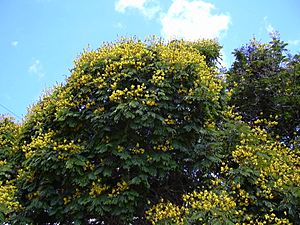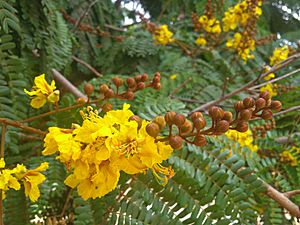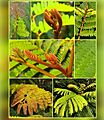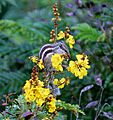Peltophorum pterocarpum facts for kids
Quick facts for kids Peltophorum pterocarpum |
|
|---|---|
 |
|
 |
|
| Flowers with buds | |
| Scientific classification | |
| Kingdom: | |
| (unranked): | |
| (unranked): | |
| (unranked): | |
| Order: | |
| Family: | |
| Genus: |
Peltophorum
|
| Species: |
P. pterocarpum
|
| Binomial name | |
| Peltophorum pterocarpum (DC.) K.Heyne
|
|
| Synonyms | |
|
|
Peltophorum pterocarpum is a beautiful tree known by many names. Some common names are copperpod, yellow-flamboyant, yellow flametree, and yellow poinciana. This tree is originally from tropical southeastern Asia. It is a very popular ornamental tree grown in many places around the world.
Contents
Discovering the Copperpod Tree's Features
The copperpod is a deciduous tree. This means it loses its leaves every year. It can grow quite tall, usually between 15 and 25 meters (about 50 to 80 feet). Sometimes, it can even reach up to 50 meters! The trunk can be as wide as 1 meter. This tree belongs to the Leguminosae family, which includes many plants that produce pods.
Understanding Copperpod Leaves and Flowers
The leaves of the copperpod tree are special. They are called bipinnate leaves. This means they are divided into smaller sections, which are then divided again into even smaller leaflets. Each leaf can be 30 to 60 centimeters long. They have 16 to 20 main sections, and each section has 20 to 40 small oval leaflets. These leaflets are about 8 to 25 millimeters long.
The flowers are bright yellow and about 2.5 to 4 centimeters wide. They grow in large clusters called racemes, which can be up to 20 centimeters long. The tiny pollen grains from these flowers are about 50 microns in size.
Copperpod Fruit and Life Cycle
After the flowers bloom, the tree produces fruits. These fruits are pods, which look like flattened beans. They are 5 to 10 centimeters long and 2.5 centimeters wide. When they first appear, they are red, but they turn black as they ripen. Each pod usually holds one to four seeds. Copperpod trees typically start to flower and produce these pods after about four years of growth.
Where Copperpod Trees Grow Naturally
Peltophorum pterocarpum is native to tropical southeast Asia and northern Australasia. You can find it growing naturally in countries like Australia, Sri Lanka, Indonesia, Malaysia, Papua New Guinea, Philippines, Thailand, and Vietnam. In Vietnam, it is known as Lim xẹt. It is also found in India.
Uses of the Copperpod Tree
The copperpod tree is very popular in tropical areas. People often plant it as an ornamental tree because of its beautiful yellow flowers. It is widely grown in places like India, Nigeria, Pakistan, and parts of the United States, such as Florida and Hawaii.
Cultural and Decorative Uses
In Telangana State in India, the flowers are used for the Batukamma festival, which is a celebration of flowers. In some cities in India, like Mumbai, copperpod trees are planted alternately with Delonix regia (also known as Gulmohar or Flame tree). This creates a stunning display of yellow and red flowers during the summer.
Practical Uses of Copperpod Wood and Foliage
The wood from the copperpod tree is quite useful. It is used for making furniture, especially cabinets. The leaves and branches, also known as fodder, can be used as food for animals. In Indonesia, a brownish color called sogan, used for traditional batik cloth, is made from the P. pterocarpum tree. In Indonesia, this tree is called soga.
Images for kids
See also
 In Spanish: Peltophorum pterocarpum para niños
In Spanish: Peltophorum pterocarpum para niños









